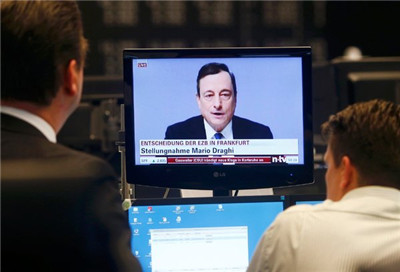(单词翻译:单击)
The program to try to jolt the European economy out of its doldrums that Mario Draghi unveiled Thursday is several months late, timid compared with its counterparts in the United States and Japan, and full of complexity aimed at satisfying his political constituents.
马里奥·德拉吉(Mario Draghi)周四公布的计划旨在让欧洲经济摆脱低迷。这一计划不仅迟到了好几个月,而且与美国和日本的同类计划相比缺乏魄力,为了让政治支持者满意,也平添了复杂性。
It may also be the last, best hope to prevent Western Europe from sliding toward another lost economic decade, with the high unemployment and geopolitical strains that would imply.
考虑到当前的高失业率,以及它可能带来的地缘政治压力,该计划或许是防止西欧经济滑进另一个“失去的十年”的最后希望,同时也是最大的希望。

The program is bigger than analysts were expecting, and its details show a commitment by the E.C.B. not to bend to political pressure (particularly from Germany) to hold its fire for fear of the monetary authority subsidizing reckless borrowing by Southern European countries. The action was enough to drive European stocks up and the euro currency down, just the market reaction that Mr. Draghi was surely hoping for.
该计划的规模大于分析人士的预期,其细节展示出了欧洲央行(European Central Bank)不屈从于政治压力(尤其是来自德国的政治压力)的决心。后者害怕欧洲央行为南欧国家不计后果的借贷提供补贴,于是向其施压,试图阻止它采取行动。该计划足以驱动欧洲股价上涨,欧元汇率下降,当然这正是德拉吉所期待的市场反应。
There’s no question that Mr. Draghi showed guile and savvy in guiding a fractious committee of central bankers to a bigger and more aggressive program than seemed plausible even a few weeks ago. The trillion-euro question is whether it will be enough, and that’s where the finer details come into play. The program’s success or failure will depend on whether the compromises needed to gain agreement will prove minor enough not to undermine its goals — and whether they have succeeded in shocking decision makers across Europe into a belief that it is riskier to hoard money than to spend and invest it.
毫无疑问,德拉吉展示出了智慧和精明,他引导着一个由各国央行行长组成的难以驾驭的委员会,达成了一份不光是似乎可行,而且规模和力度都更大的计划。问题在于,几万亿欧元是否够用,这也是那些更为微观的细节发挥作用的地方。该计划的成败,取决于达成共识所要做出的妥协是否能小到不足以影响目标的实现,以及是否成功地让欧洲的决策者在冲击之下相信,囤积资金比消费和投资更有风险。
Mr. Draghi, the president of the European Central Bank, announced plans to buy 60 billion euros’ worth of bonds per month through at least September 2016, which would imply 1.1 trillion euros ($1.3 trillion) in new money injected into the European financial system. The plan is to continue until the central bank’s leaders judge that inflation is returning toward the goal of below but close to 2 percent. For the year ended in December, prices actually fell 0.2 percent in the 19 countries using the euro currency.
欧洲央行行长德拉吉宣布了每月购买600亿欧元债券的计划,该做法将至少持续到2016年9月,这意味着将有1.1万亿欧元(约合8万亿元人民币)的新资金注入欧洲的金融系统。该计划将一直持续下去,直到欧洲央行的官员们认为通胀水平回到了接近但低于2%的目标。在截至去年12月的一年时间里,19个使用欧元的国家里,物价实际上降低了0.2%。
At first glance, Mr. Draghi’s plan emulates the Federal Reserve’s QE3 program: the third round of quantitative easing, or bond buying, announced in the United States in September 2012 and which most likely helped the acceleration in the American economy over the last two years. Both programs were open-ended in size, with billions in monthly bond purchases paired with a pledge to continue until some goal is met (for the Fed, it was substantial improvement in the job market, for the European Central Bank, returning inflation toward its target).
从表面上看,德拉吉的计划似乎效仿了美联储(Federal Reserve)的QE3:也就是美国在2012年9月宣布的第三轮量化宽松(quantitative easing),或者说债券购买计划。这一行动在过去两年里,极有可能为美国经济的加速提供了助力。两个计划在规模上都没有限制,每月的购债规模达数十亿美元,并承诺将一直如此,直到实现某个目标(对于美联储来说,这个目标是就业市场出现实质性改善,对于欧洲央行来说,是让通胀回到目标水平)。
There are two big differences.
但它们有两个主要区别。
First, it is late. When the Fed pulled the trigger on its open-ended bond buying, in 2012, annual inflation was running at 1.6 percent in the United States, not far below its 2 percent target. The economy was growing at a steady if unexceptional rate. The Fed was looking to get ahead of its problem of sluggish growth.
首先,欧洲央行的计划来得太晚。当美联储2012年启动无上限的购债行动时,美国的年度通胀率为1.6%,并没有远远低于2%的目标水平。经济增长尽管缓慢,但是很稳定。美联储当时正在寻求克服增长乏力的问题。
The European Central Bank, by contrast, has spent the last two and a half years seemingly looking for any excuse not to take the action announced Thursday, with a series of half-measures. The difference has its roots in differing economic analysis about the dangers of deflation and complex political factors, in particular the aversion of Europe’s central bankers and German political leaders to use the common central bank to share risk among different countries.
相比之下,在过去两年半时间里,欧洲央行似乎一直在找各种借口,避免采取周四宣布的这种行动,并推出了一系列权宜之计。这一差异的根源包括对通货紧缩危险的经济分析存在的分歧,以及复杂的政治因素,尤其是欧洲各国央行行长和德国领导人不愿用共同的中央银行分担各国的风险。
The second big difference with the American program is that the E.C.B. is only dabbling with risk-sharing across Europe.
与美国的计划相比,第二大不同是,在让整个欧洲共同承担风险方面,欧洲央行只是浅尝辄止。
The European Central Bank in Frankfurt administers its policies through national central banks across the eurozone: the Bundesbank in Germany, the Banca d’Italia in Italy, and so on. A big question has been whether any losses due to government defaults or restructurings on bonds bought through this quantitative easing program would be borne by Europe as a whole or the specific national bank that bought the bonds.
位于法兰克福的欧洲央行是通过欧元区内各国的央行,如德国联邦银行(Bundesbank)和意大利银行(Banca d’Italia)等来执行其政策的。一个重要的问题是,因为政府违约而造成的损失,以及量化宽松计划所购债券发生重组时造成的损失,该由整个欧洲,还是由购买债券的具体某国央行来承担。
The German government would strongly prefer the risks stay on national books. Why, they reason, should Germany’s central bank pay the bill if Portugal defaults on its obligations?
德国政府会强烈赞成各国央行承担风险。他们的理由是,如果葡萄牙违约了,德国央行为什么应该买单?
The problem is that doing this eliminates one of the crucial ways that a central bank can act as guarantor of a nation’s economy. The European Central Bank isn’t much of a lender of last resort if each country within the eurozone is on its own when things turn bad. It would be as if the Federal Reserve system as a whole had refused to stand behind the Federal Reserve Bank of Atlanta when it was making emergency loans to failing banks in Florida during the financial crisis; part of the strength of the system is that the entirety of the United States government, and its central bank, stood behind each component part.
问题是,这么做就减少了中央银行作为一国经济的担保机构,所能采取的一种关键举措。如果形势恶化时,欧元区各国都各自为战,欧洲央行就算不上是“最后贷款人”。这就好比金融危机期间,亚特兰大联邦储备银行(Federal Reserve Bank of Atlanta)向佛罗里达州濒临倒闭的银行提供紧急贷款时,整个美联储系统拒绝充当后盾一样。美联储系统的实力,部分来源于各个成员背后,都有整个美国政府及其央行的支持。
Mr. Draghi was dismissive of the importance of this risk mutualization debate in his news conference Thursday, but the plan he unveiled shows the hallmarks of an intricate negotiation to have some elements of risk sharing and some risk remaining on the books of individual national banks.
在周四的新闻发布会上,德拉吉对于风险共担讨论的重要性不屑一顾。但在他宣布的计划中,有迹象显示,各方进行了一场繁琐的谈判,使其包含了一些风险共担的成分,同时各国央行也要自行承担部分风险。
For nearly eight years, since the first tremors of what would become the global financial crisis were felt, global central banks have been the first responders, for better and worse, to a rolling series of panics and disappointing economic results. (The better: They have often moved more decisively and powerfully than elected officials. The worse: Their tools are often ill-suited for the challenges their economies have faced, and created dangerous ripple effects).
在全球金融危机的影响开始显现后的近八年时间里,面对一波接一波的恐慌和欠佳的经济指标,各国央行一直都能率先做出应对,无论效果好坏。(好的方面:它们的行动通常都比民选官员更果断、更有力。不好的方面:它们的工具常常无法适应所在经济体面临的挑战,并且造成了危险的涟漪效应。)
Mr. Draghi’s move is firmly within this tradition. We don’t know how it will end, only that he has shown the determination to recognize that the status quo, for Europe and the world, was no good.
德拉吉的举措完全遵循了这一传统。我们不知道结果会如何,只知道他已表现出了决心,承认对欧洲和全世界来说,现状都不好。


